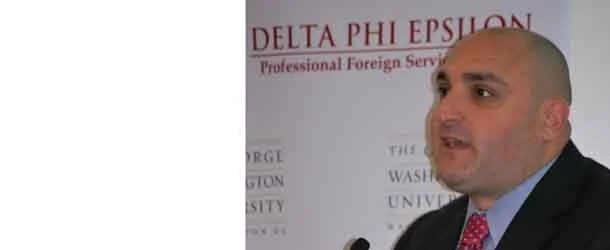EVENT: Bill Roggio on “Mapping the War on Terror”
Bill Roggio, managing editor of The Long War Journal (LWJ), spoke to a large audience at the Elliott School of International Affairs on October 20, 2010. The LWJ is a project of the Foundation for Defense of Democracies that strives to provide original and accurate analysis of the “long war” against terrorism. Roggio is a former soldier and was in the New Jersey National Guard. After he left the military, he worked in private industry. Roggio, who never intended to become a reporter, began his journalism career by blogging about the war in Iraq. In 2004, after blogging about a battle in Fallujah, he realized that there was a need for more accurate reporting and he started tracking events. Eventually, he was contacted by US Marines commanders, who liked his briefings and who invited him to become embedded in Iraq in 2005. Since then he has followed events and tracked terrorists. He worked during 2005-08 as an embedded reporter with the US Marines, the US Army, the Georgian Army, the Iraqi Army and the Iraqi police in Iraq. He was also embedded in Afghanistan in 2006 with the Canadian Army in. He now writes the US war against terrorists for The Long War Journal.Roggio presented several main points in his talk to the GWU audience regarding the war in Afghanistan, Al Qaeda in Afghanistan and Pakistan and the threat against the West.After the September 11th attacks on the United States, Al Qaeda and the Taliban regrouped in northwest Pakistan where they now plan insurgency, recruit, rearm and infiltrate. Roggio believes that the U.S. and NATO were not prepared for the insurgency in Afghanistan and, as a result, the NATO mission was under-manned and under-resourced when the war began. Additionally, the U.S. has not found a stable partner in the Afghan government. The Taliban has established shadow governments in 33 of 34 provinces and spread insurgency.In Afghanistan, Al Qaeda is closely aligned with the Afghan Taliban, the Haqqani Network, Hizb-i-Islami Gulbuddin, and the Quetta Shura. Their fighters serve as trainers and assist in combat. Roggio also doubts that there are only 50-100 Al Qaeda bases in Afghanistan. He tracks Al Qaeda and Taliban operatives by tracking military press releases. Recently, the area of Kunar was nearly overrun by these forces when the US withdrew from small outposts. The Taliban claimed that US occupation of those outposts was the problem and urged the US to pull out, leaving the area for locals. Roggio criticized the US military for pulling out of these areas, because the Taliban, instead of leaving the area to the locals, declared victory and took them over.The main threat to the West, however, comes from Al Qaeda’s operations network based in the Federally Administered Tribal Areas (FATA) of Pakistan. From FATA, Roggio has traced plots against the West and India, including the suicide bombings in the London underground in July 2005, the plot against transatlantic airlines in 2006, the Times Square plot of May 2010, and the recent threats against Europe.In Pakistan, Al Qaeda is integrated with Tehrik-i-Taliban (TTP) and the Haqqani network. Lashkar-e-Taiba, a homegrown Pakistani terrorist group founded by Hafiz Saeed, is known as “Al Qaeda Junior.” Its focus has been to remove Indian forces and control from the disputed Kashmir region. Like Hezbollah, it has a civilian group to provide aid and also has a fighting group. Roggio asserts that the Pakistani army gives them cover. He stated that claims that only 300-400 Al Qaeda fighters are in Pakistan are too low.Roggio emphasizes that the use of predators against these terrorists is a tactic, and not a strategy. Despite its public objections, Roggio believes that Pakistani army tacitly approves of US predator strikes. The “pros” of predator strikes are that they help to eliminate terrorist leaders, forcing the inexperienced leaders to take command, and they put terrorist groups on defense, making fighters plan for survival, not operations. The “cons” of these strikes are that they put the US and allies at risk, cause civilian deaths and civilian backlash to these deaths, and they are no substitute for holding ground. Al Qaeda is still plotting despite being hit by predator strikes.The US has tried to pressure the Pakistani government to act against the Al Qaeda and Taliban bases in the FATA, but Pakistan has only responded with half-hearted military offensives against these fighters. Pakistan made peace deals with these groups beginning in 2004 in North and South Waziristan and by 2009 to the Swat valley in northern Pakistan. Roggio believes that the Pakistani government has failed to support US military operations in Afghanistan.Additionally, Pakistan gives cover to these terrorist groups in Pakistan because they are viewed as “assets” against India and Indian control of Kashmir. The Pakistani government wants to gain influence in Afghanistan after the US has left and is opposed to Indian influence there. Roggio believes the real government of Pakistan is leadership of the security forces – military generals and the top ranks of ISI, the Pakistani intelligence agency. Ultimately, he cautions that the war in Pakistan and Afghanistan is very complex and that the US must persevere, but that to do so, it will have to take many more casualties. The event was sponsored by the Delta Phi Epsilon Professional Foreign Service Sorority. This photo is courtesy of Denise Tugade, Publicity Chair of Delta Phi Epsilon Professional Foreign Service Sorority, Eta Chapter at The George Washington University.
